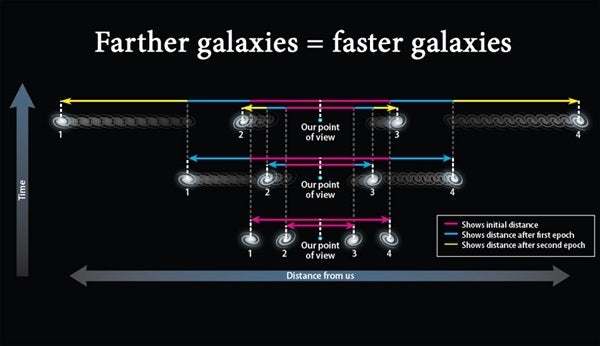If an object is 10 billion light-years away, this doesn’t imply that it took the light 10 billion years to travel this distance — the universe is expanding and was smaller in the past. So, light that crossed 1 mile in the early universe stretches with time, and, at some later time, becomes 2 miles, and, still later, 3 miles, etc. Therefore, the total distance in light-years as measured today is greater than the actual time of travel (as measured by a stopwatch) multiplied by the speed of light. The most distant object we can see in the universe today — that is, the limit of the observable universe — would be roughly 45 billion light-years away, even though the universe itself is only about 13.7 billion years old.
The idea that nothing can move faster than light is potentially misleading. Relative velocity does not make sense unless the specific objects are close to each other. It is in this limit where the laws of Einstein’s theory of special relativity, and this statement, apply. The expansion of the universe, on the other hand, is actually the stretching of space and is not limited by special relativity. Any given distant galaxy may look like it is receding from us at great speed — even apparently faster than the speed of light — but this is only because the “fabric” of space between the object and us is stretching.
Finally, if we see two galaxies in opposite directions, and each is 10 billion light-years away, this does not necessarily mean they are 20 billion light-years away from each other. The reason is complicated: In cosmology, there are several definitions of distance depending on which measuring technique we use.
For example, we can infer distance to an object from the amount of light we collect using a camera attached to a telescope. We call this the luminosity distance. Or, we can measure the distance based on the angular size of the object as seen through the telescope. This is called the angular-diameter distance. In neither of these definitions is the total distance between two objects equal to twice the distance to each one.
Not surprisingly, the various definitions agree on scales where separations are smaller than 100 million light-years. This is far outside of our galaxy, but, nevertheless, much closer than many other objects we see with today’s powerful telescopes. Beyond this short-distance limit, distances to two objects located opposite each other relative to us can’t be added to get their mutual separation. — DRAGAN HUTERER, KAVLI INSTITUTE FOR COSMOLOGICAL PHYSICS, UNIVERSITY OF CHICAGO










